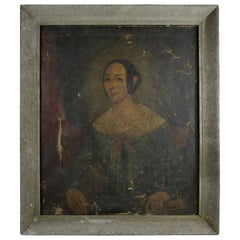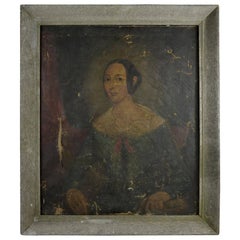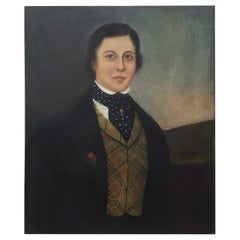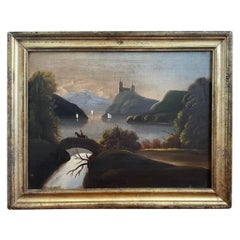Bleached Paintings
to
1
2
2
2
2
2
2
2
2
2
2
2
2
2
2
Technique: Bleached
Naive Portrait of a Girl, English, Early 19th Century
Located in St Annes, Lancashire
Wonderful naive oil painting of a girl.
Fabulous muted colors. The austerity of the image is matched by the simplicity of the antique bleached oak frame.
I have chosen not to resto...
Category
1840s English Folk Art Antique Bleached Paintings
Materials
Canvas, Oak
Primitive Portrait of a Girl, English, Early 19th Century
Located in St Annes, Lancashire
Wonderful naive oil painting of a girl.
Fabulous muted colors. The austerity of the image is matched by the simplicity of the antique bleached oak frame.
I have chosen not to resto...
Category
1840s English Folk Art Antique Bleached Paintings
Materials
Canvas, Oak
Related Items
Early 19th Century Oil Portrait of a Handsome Young Man
Located in San Francisco, CA
Early 19th century oil portrait of a handsome young man
An original painting of a young man wearing his best suit of clothes.
Original oil on ...
Category
Early 19th Century American Antique Bleached Paintings
Materials
Canvas
19th Century American Folk Art Oil Painting Landscape Sailboats On River
Located in Stamford, CT
A 19th century American folk art oil painting on canvas depicting a river scene at dawn with a horse and rider on a bridge over a waterf...
Category
Mid-19th Century American Folk Art Antique Bleached Paintings
Materials
Canvas
Painting “Venice by Moonlight” by K. Nufer, Munich Late 19th Century
Located in Berghuelen, DE
Painting “Venice by Moonlight” by K. Nufer, Munich Late 19th Century
Item e7431
Magnificent antique painting in oil on canvas. Painted by K. Nufer Munich in the late 19th century. Th...
Category
Late 19th Century German Victorian Antique Bleached Paintings
Materials
Canvas, Wood
19th Century Italian Naive Flower Painting
Located in Vosselaar, BE
A anonymous Italian 19th century flower painting, oil on wood. The flowers in a gold colored bouquet vase with a scrolled base. Resting o...
Category
Mid-19th Century Italian Antique Bleached Paintings
Materials
Wood
19th C Framed Fraktur Watercolor Painting
Located in Los Angeles, CA
Beautiful 19th C Fruktur by Martha Geist
The poem on the Fruktur (watercolor) is re-written below.
"If my name heaven is my station, This world is my habitation.
Christ is my ...
Category
19th Century American Country Antique Bleached Paintings
Materials
Wood
Swedish 19th Century Folk Art Oil Painting With Kids
Located in Haddonfield, NJ
Swedish naive oil painting with the original frame, from the 2nd part of the 19th Century.
This folk art work on canvas represents kids and a dog playing by a courtyard, opening the...
Category
Late 19th Century Swedish Folk Art Antique Bleached Paintings
Materials
Canvas, Wood
19th c. Mexican Retablo "Veronica's Veil" c.1880
Located in San Francisco, CA
ABOUT
An original 19th century Mexican folk retablo "Veronica's Veil" or "El Divono Rostro" in Spain . Oil paint on tin.
The Veil of Veronica, known in Italian as the Volto Santo or Holy Face, is a Roman Catholic Relic which, according to legend, bears the likeness of the Face of Jesus that was imprinted on it prior to Jesus' crucifixion. According to Roman Catholicism, Saint Veronica encountered Jesus in Jeruselum on the way to Calvary. When she paused to wipe the sweat (Latin, suda) off his face with her veil, his image was left on the veil.
In the small village of Osa de la Vega in Spain, there lived a couple who led a very pious life. They were Gregorio de la Torre and Isabel Corral. From their father, Juan Montilla, they inherited a picture of the Face of Jesus or the Divino Rostro. A story that is told one day, to the amazement of many who confirmed its veracity, the picture began to perspire with living blood. News of this extraordinary event spread swiftly and widely throughout the land.
CREATOR Unknown.
DATE OF MANUFACTURE c.1880.
MATERIALS AND TECHNIQUES Oil Paint on Tin.
CONDITION Good. Wear consistent with age and use.
DIMENSIONS H 14 in. W 10 in.
HISTORY
Retablos, better known as 'laminas' in Mexico, are small oil paintings on tin, wood and sometimes copper which were used in home altars to venerate the almost infinite number of Catholic saints. The literal translation for 'retablo' is 'behind the altar.' This unique genre of art, deeply rooted in European history, was brought to Mexico with the arrival of the Spanish and then ultimately adopted by New World mestizo natives to become what is known today as the Mexican folk retablo.
The retablo was an art form that flourished in post conquest Mexico and then ultimately, with the introduction of inexpensive mediums such as tin, reached its pinnacle of popularity in the last quarter of the 19th century. With some exceptions, mostly untrained artists from the provinces worked to produce and reproduce these sacred images; some subjects painted more prolifically than others. A typical "retablero" may have reproduced the same image hundreds, if not thousands of times in his or her career.
These oil paintings were sold to devout believers who displayed them in home altars to honor their patron saints. There are virtually hundreds of saints, each invoked to remedy a different situation. "San Ysidro Labrador," the patron saint of farmers, is venerated for good weather...
Category
19th Century Mexican Folk Art Antique Bleached Paintings
Materials
Tin
Danish Early 19th Century Oil Painting Of A Farm House
Located in Haddonfield, NJ
Danish early 19th Century oil painting of a farm house in a period gilded frame.
Category
Early 19th Century Danish Romantic Antique Bleached Paintings
Materials
Canvas, Wood
Late 19th Century Wood Framed Folk Art Painting Depicting Hound Dogs by River
Located in Middleburg, VA
Late 19th Century Wood Framed Folk Art Painting Depicting Hound Dogs by River. The two dogs are hunting water fowl. Wood framing is modern. United States, 1...
Category
Late 19th Century American Folk Art Antique Bleached Paintings
Materials
Canvas, Paint
H 10 in W 25.5 in D 1 in
19th Century Folk Art Painting of a Young Girl
Located in Rio Vista, CA
Interesting 19th century Folk Art painting of a young girl holding a bible. Oil on canvas with a treed landscape and blue sky. Set in a deep carved giltwood frame with repeating bord...
Category
19th Century European Folk Art Antique Bleached Paintings
Materials
Canvas, Wood
Pair Antique 19th Century Indian Miniature Mica Paintings C.1830
Located in London, GB
Pair Antique 19th Century Indian Miniature Mica Paintings C.1830
Indian Company School
A pair of 19th Century Indian mica gouache paintings on mica.
Depicting the water carrier and of a Purdah bullock...
Category
19th Century Indian Antique Bleached Paintings
Materials
Paper
19th C. Mexican Retablo "Veronica's Veil", c.1880
Located in San Francisco, CA
About
An original 19th century Mexican folk retablo "Veronica's Veil" or "El Divono Rostro" in Spain . Oil paint on tin.
The Veil of Veronica, known in Italian as the Volto Santo or Holy Face, is a Roman Catholic Relic which, according to legend, bears the likeness of the Face of Jesus that was imprinted on it prior to Jesus' crucifixion. According to Roman Catholicism, Saint Veronica encountered Jesus in Jeruselum on the way to Calvary. When she paused to wipe the sweat (Latin, suda) off his face with her veil, his image was left on the veil.
In the small village of Osa de la Vega in Spain, there lived a couple who led a very pious life. They were Gregorio de la Torre and Isabel Corral. From their father, Juan Montilla, they inherited a picture of the Face of Jesus or the Divino Rostro. A story that is told one day, to the amazement of many who confirmed its veracity, the picture began to perspire with living blood. News of this extraordinary event spread swiftly and widely throughout the land.
CREATOR Unknown.
DATE OF MANUFACTURE c.1880.
MATERIALS AND TECHNIQUES Oil Paint on Tin.
CONDITION Good. Wear consistent with age and use.
DIMENSIONS H 14 in. W 10 in.
HISTORY
Retablos, better known as 'laminas' in Mexico, are small oil paintings on tin, wood and sometimes copper which were used in home altars to venerate the almost infinite number of Catholic saints. The literal translation for 'retablo' is 'behind the altar.' This unique genre of art, deeply rooted in European history, was brought to Mexico with the arrival of the Spanish and then ultimately adopted by New World mestizo natives to become what is known today as the Mexican folk retablo.
The retablo was an art form that flourished in post conquest Mexico and then ultimately, with the introduction of inexpensive mediums such as tin, reached its pinnacle of popularity in the last quarter of the 19th century. With some exceptions, mostly untrained artists from the provinces worked to produce and reproduce these sacred images; some subjects painted more prolifically than others. A typical "retablero" may have reproduced the same image hundreds, if not thousands of times in his or her career.
These oil paintings were sold to devout believers who displayed them in home altars to honor their patron saints. There are virtually hundreds of saints, each invoked to remedy a different situation. "San Ysidro Labrador," the patron saint of farmers, is venerated for good weather...
Category
19th Century Mexican Folk Art Antique Bleached Paintings
Materials
Tin



